The AMD Llano Notebook Review: Competing in the Mobile Market
by Jarred Walton & Anand Lal Shimpi on June 14, 2011 12:01 AM ESTBattery Life: All Day Computing
AMD makes a point of their mobile offerings (A/C/E-series APUs) all offering “all day computing”, with a note that “all day” is defined as eight hours or more. While that’s easy to do with a gigantic battery, doing so with the typical 48/56Wh batteries in mainstream laptops is a lot more difficult. One of their test notebooks apparently manages around 10.5 hours (best-case) with a 62Wh battery, compared to 6.5 hours for a similar Core i5-2410M laptop. Without specifics on all the settings, we’ll just say that our results for “similar” laptops don’t show nearly the disparity AMD achieved, but the important point is that AMD is finally competitive in battery life.
We ran our usual series of battery life tests, with the LCDs set for ~100 nits (70% brightness for the Llano laptop). We shut off WiFi for the idle test and mute audio; the Internet test is run over WiFi and repeatedly loads four tabs of content every minute, again with audio muted; finally, the H.264 playback result is done with a set of earbuds connected and WiFi disabled. Here’s how the Llano laptop stacks up to some recently reviewed laptops—you can compare Llano with other laptops in Mobile Bench.
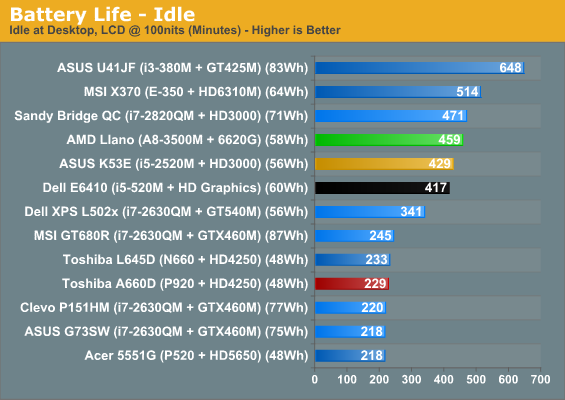

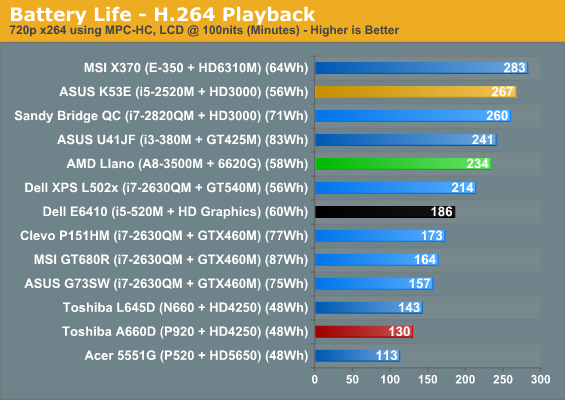
Starting with pure battery life, only three laptops consistently offer longer battery life than the Llano system: the ASUS U41JF, MSI’s X370, and the quad-core Sandy Bridge notebook. Also, the ASUS K53E boasts better battery life in the H.264 playback test, which for whatever reason is a test where SNB has proved particularly potent. Intel’s DXVA decode may be efficient, but it's also possible it's doing less work; we're running the test again with all of AMD's video enhancement features turned off. [Update: I retested with all the AMD video enhancement features disabled, and battery life didn't change, so Intel is simply more efficient at H.264 decoding with SNB.]
Back to the discussion of battery life: all three of the laptops that beat Llano have the advantage of slightly to moderately higher battery capacities, so the comparison isn’t entirely fair. Let’s level the playing field by looking at relative battery life.
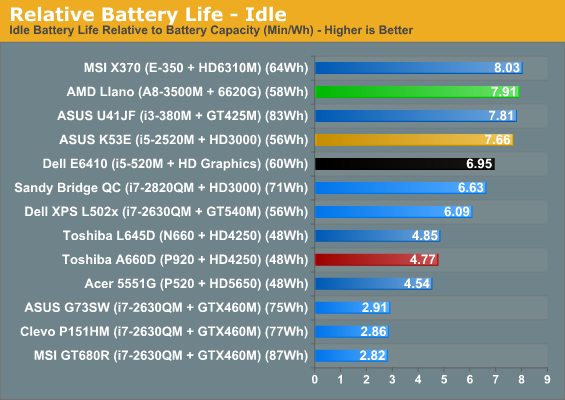
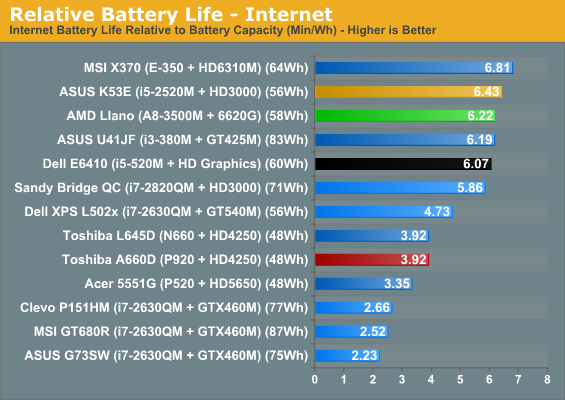
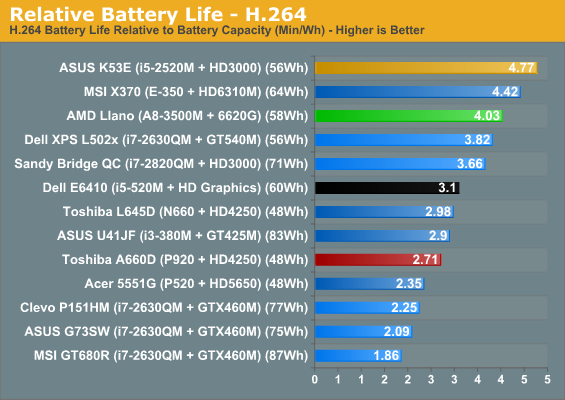
Rather amazing is that Llano actually rises to the top of the charts in the Idle test, and it’s only slightly behind the competition in the other two tests. Considering the X370 is equipped with an E-350 APU, the fact that Llano is even close is surprising. While we should note that the X370 wasn’t the most efficient of the E-350 laptops we’ve tested, we also need to point out that the 13.3” LCD is a lot closer to the 14” panel in the Llano notebook than the 11.6” panels used in the Sony YB and HP dm1z. The dual-core SNB notebook still leads in the H.264 test, and considering it has a 15.6” panel we’d say that relative battery life is very similar between the two.
We also want to talk about AMD’s claims of “all day battery life”. If we accept their definition of 8+ hours, the test laptop doesn’t actually hit that mark in our idle test. We did run the same test again at 40% LCD brightness (around 60 nits) and managed eight hours exactly, but that’s in an absolutely best-case test. For Internet surfing, which represents a more useful metric, the best way to get 8+ hours is demonstrated by ASUS’ U41JF: stuff in a higher capacity battery!
Rounding out the battery life discussion, we also tested battery life while looping 3DMark06 at native resolution (1366x768). This represents a reasonable 3D gaming scenario, and Llano still managed a reasonable 161 minutes. Considering graphics performance is a healthy step up from what Intel’s HD 3000 offers and that AMD manages double the battery life under gaming situations compared to the K53E, mobile gaming is clearly a win.
Overall, for the first time in a long time, AMD is able to offer battery life that competes with and even exceeds what Intel offers with their current mainstream offerings. There are of course a bunch of lower power Intel CPUs we could discuss, but looking at the 35W TDP parts the combination of 32nm and power gating has brought AMD back into the discussion. Even more interesting is that you should be able to get something like our test laptop for $600, possibly less, compared to dual-core SNB i5 laptops that start at $700. But then, perhaps Core i5 isn’t the best comparison for quad-core Llano, despite what AMD might like to say? Let’s move on to general performance and gaming discussions before we decide which mobile part is the “best”.










177 Comments
View All Comments
ionave - Thursday, June 16, 2011 - link
I'm honestly sick of the fact I can't play TF2 on high settings on my laptop AND I cannot find an affordable computer to do so while I'm not paying attention during class. Several people I know feel the same way.krumme - Tuesday, June 14, 2011 - link
The GPU performance hits dues to the shares bus is very low. Getting NV 540 /ati 5650 performance is far better than most expected.Battery life is simply amazing. Far better than expected.
The OEM is standing at a very long line for this.
GeorgeH - Tuesday, June 14, 2011 - link
That battery life is incredibly impressive. That AMD will finally have a competitive mobile offering is huge news; their engineers definitely deserve a pat on the back. Let's just hope that OEMs don't mess things up by cutting costs and shipping Llano laptops with tiny batteries.Unfortunately AMD will almost certainly struggle to get the message across that their CPU performance deficit is pretty much irrelevant for the vast majority of mobile usage models. It'll be especially difficult to get across to the huge number of consumers that think a 2GB 6570 is better than a 768MB GTX 460, but I wish AMD's marketing department the best of luck.
Dribble - Tuesday, June 14, 2011 - link
They'll struggle because cpu performance deficit does matter, cpu performance matters more then gpu performance for most of us. While llano might be *enough* today everyone buys a notebook and expects it too last several years.If llano currently only has the performance of a notebook several years old (core 2 intel) then you can bet in 3 years it'll be dog slow.
Really its only a winner for a pretty small margin of people. If you don't really care about gaming you go intel because cpu's are faster, if you really care about gaming you go intel + discrete. That leaves those who really care about gaming but are on an extremely tight budget.
ET - Tuesday, June 14, 2011 - link
I think that you underestimate the effect of price. If you really care about gaming you go desktop, anyway. If you want a reasonable size laptop with good battery life and capable of some gaming, Llano will fit the bill, and if it sells considerably lower than the competition, then I'm sure a lot of people will buy it. It won't be anyones main gaming rig, but it will surely serve many as a secondary one.I agree that Llano is disappointing at the CPU level, but it really should be enough for most people. How well it sells will depend on pricing. There are big E-350 laptops being sold, which boggles the mind, and there wouldn't be if all people really cared or had any clue about performance.
ppeterka - Tuesday, June 14, 2011 - link
I strongly disagree with you. My first notebook was exceptionally crappy in terms of raw CPU power. Desktop P4 Celeron 2.6GHz was used to power it. Yet I could use it for more than 4 years, after which I changed the CPU to a 2.8GHz P4, only to discover that the "user experience" was left unchanged except of the rare cases when I used the computer to work on it. Compile times were not left unchanged...But even with the Celeron in, the casual usage was just fine. Why? Because of the quite nice VIA IGP in it. I could actually play GTA San Andreas on the poor thing - even though there were times it was not very much fun, but it did work. Swapping the CPU didn't make it much better, only considering work duties.
Today "everything" is about multimedia. By "everything" I mean 80% of what the people are doing. Youtube, Facebook, who-knows-what, all. None of my friends ever regretted heeding to my advice to choose a notebook with a reasonable graphics solution even when there would be an altenative type with a stronger CPU. (of course not to the extremities). Granted, they were not primarily interested in scientific calculations, or heavy duty software development.
Dribble - Tuesday, June 14, 2011 - link
Multimedia doesn't need llano's gpu - SB graphics accelerates video just fine. Hence why you are recommending something that has better 3D graphics performance they'll never use, over something with a faster cpu which they will use all the time?GeorgeH - Tuesday, June 14, 2011 - link
You claim that CPU performance matters. That's true, but can you answer the following -1) Consider two laptops side by side. One has a ~2.5GHz C2D, one has a quad-core Sandy Bridge. Name a single task more than 5% of mobile users run that would allow you to definitively tell which laptop is running the C2D and which has the SB. (Task Manager doesn't count, I'm talking actually using an application.)
2) Name a single task or application that theoretically might let you do the above once it's widespread in the next 3-5 years.
3) What percentage of laptops are sold for <$1000 with roughly Llano or below levels of graphics?
4) What percentage of laptop buyers care about battery life?
My answers are -
1) No clue
2) No clue
3) Most of them
4) Most of them
That's why I say that Llano's battery life is huge and its CPU performance really doesn't matter. Even Intel agrees, which is one reason why you're seeing them move towards lower-power CPUs. Ivy Bridge will have "configurable" TDP, and Haswell will move from 35-35W to 10-20W:
http://www.anandtech.com/show/4378/ivy-bridge-a-ti...
RussianSensation - Tuesday, June 14, 2011 - link
3) The fact is you can get a laptop with better GPU performance and faster CPU performance for $700-750 on the Intel side:i5 480 + HD5730 for $700:
http://www.newegg.com/Product/Product.aspx?Item=N8...
i5 480 + GT 540M (which beat 6620 in almost every gaming benchmark in this review) for $700:
http://www.newegg.com/Product/Product.aspx?Item=N8...
i5 480 + HD6550M for $700:
http://www.newegg.com/Product/Product.aspx?Item=N8...
i5 2410 + GT 540M for $750:
http://www.newegg.com/Product/Product.aspx?Item=N8...
Every single one of these provides faster CPU & GPU performance (http://www.notebookcheck.net/Mobile-Graphics-Cards...
So Llano A-8 would need to be less than $700.
GeorgeH - Tuesday, June 14, 2011 - link
Can you find faster GPUs for <$1000? Sure, but that wasn't the question. Go to Dell or HP's website and look at the number of laptops priced under $1000, then look at the percentage of those that come with significantly better than Llano-level graphics.There's much more to determining the value of a laptop than raw CPU and GPU performance; you could easily pay more than $700 for a Llano laptop and still be getting a very good deal.
I'm not saying whether or not Llano should target this or that price point, though - I'm just trying to give a little perspective.